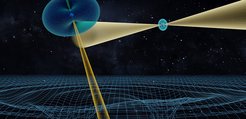Gravity Tests with the Double Pulsar Honoured
2025 Frontiers of Science Award for the international Double Pulsar research team
The research paper “Strong-Field Gravity Tests with the Double Pulsar” by an international research team with Michael Kramer (Max Planck Institute for Radio Astronomy, MPIfR) as leading author, with additional authors from MPIfR and colleagues from several countries, was published in the journal “Physical Review X” in 2021.
Their work has now received the Frontiers of Science award within the category “Astrophysics and Cosmology – theory”. The award ceremony took place at the China National Conference Center (CNCC) in Beijing - on July 13, 2025.

The International Congress for Basic Science (ICBS) in China honours top research achievements which are both excellent and of outstanding scholarly value. For the 2025 selection, scientific works in both basic and applied research were chosen in the three basic science fields, mathematics, theoretical physics, and theoretical computer and information sciences. Among those selected was the work of an international research team led by Michael Kramer (Max Planck Institute for Radio Astronomy, Bonn, Germany) with a number of co-authors from several countries, who had presented their results in a publication entitled “Strong-Field Gravity Tests with the Double Pulsar” in the journal “Physical Review X” (Kramer et al. 041050, December 13, 2021). The research work described in the paper received the ICBS award within the category “Astrophysics and Cosmology – Theory”.
More than 100 years after Albert Einstein presented his theory of general relativity, scientists around the world continue their efforts to find flaws in this theory. The observation of any deviation from General Relativity would constitute a major discovery that would open a window on new physics beyond our current theoretical understanding of the Universe. One of the hardest and most precise tests results from the honoured work by Kramer and his team. “We studied a system of very compact stars to test gravity theories in the presence of very strong gravitational fields,” states the research team’s leader, Michael Kramer, director at the MPIfR. “To our delight we were able to test a central prediction of Einstein’s theory, the energy carried by gravitational waves, with a precision that is 25 times better than with the Nobel-Prize winning Hulse-Taylor pulsar.”
Apart from the loss of orbital energy through gravitational waves, various other relativistic effects have been observed in this extraordinary system consisting of objects called pulsars – cosmic lighthouses acting as cosmic clocks that orbit each other in only 147 min. All observed effects are in perfect agreement with general relativity.
The eccentric orbits of the two pulsars rotate by about 17 degrees per year, which by now amounts to more than a full 360-degree turn since the system’s discovery. This relativistic advance of the pericentre is well known from the orbit of Mercury, but in this “Double Pulsar system” it is 140,000 times stronger.
Relativistic time dilation—arising from the pulsar’s motion and the gravitational field of its companion—causes the “pulsar clocks” to tick more slowly. This effect is especially significant for the fast-spinning pulsar “A”, whose eccentric orbit around the slowly spinning pulsar “B” results in a precisely measured periodic time variation of 384 microseconds due to time dilation.
Pulsar “A” spins 2643 times per minute, whereas its slower companion pulsar “B”, does that only 22 times.
Around superior conjunction, pulses from pulsar “A” travelling toward Earth pass within about 10,000 km of pulsar “B”. This close approach in pulsar “B’s” curved spacetime causes both a measurable propagation delay and a bending of their path. Thanks to the exceptional timing accuracy of pulsar A, these effects have been measured, probing spacetime curvature a million times stronger than that tested in our Solar System.
This combination of diverse effects produced by a system of two strongly self-gravitating bodies with extreme spacetime curvature makes the Double Pulsar a unique testbed — not only for general relativity but also for various of its competitors, some of which have been significantly constrained or even excluded by this experiment.
“As a theorist, investigating all these different relativistic effects in just one system was a dream come true. This work was only possible, however, by standing on the shoulders of the giants in this field of theoretical physics—one of whom, Thibault Damour, is a co-recipient of this award,” says Norbert Wex, also from MPIfR.
“The results demonstrate the unique power of the radio pulsar timing for carrying out extremely precise, and in some cases unique, tests of gravity theories, and more generally learning about the fundamental laws of our Universe,” continues Paulo Freire from MPIfR.
“This work showcases the astonishing agreement of the currently best theory of gravity with observations, including those from the Effelsberg 100m radio telescope. With great anticipation, we are waiting to see what new observations reveal in the next 5 to 10 years,” adds Ramesh Karuppusamy from MPIfR.
“We are very pleased with the award honouring our work with the Double Pulsar which is the result of a collaboration with great colleagues, who together allowed us to combine our precision experiments with a rigorous theoretical understanding,” concludes Michael Kramer.


